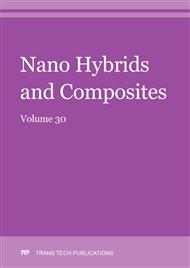[1]
ACI Committee 210, Erosion of concrete in hydraulic structure (ACI 210R-03), American Concrete Institute, USA, (2003) 1-24.
Google Scholar
[2]
A.Z. Zadeh, B. Zafari, M. Yaminpour, Multifunctional use of self-compacting concrete as a fundamental material in dam construction: Upper Gotvand dam, Key Eng. Mater. 629-630 (2015) 391-398.
DOI: 10.4028/www.scientific.net/kem.629-630.391
Google Scholar
[3]
A. Kryžanowski, M. Mikoš, J. Šušteršič, V. Ukrainczyk, I. and Planinc, Testing of concrete abrasion resistance in hydraulic structures on the lower sava river, J. Mech. Eng. 58 (2012) 245-254.
DOI: 10.5545/sv-jme.2010.217
Google Scholar
[4]
N. S. Ayoob, S. R. Abid, A. N. Hilo, Water-impact abrasion of self-compacting concrete. Mag. Civ. Eng. 96 (2020) 60–69.
Google Scholar
[5]
A. N. Hilo, S. R. Abid, Y. H. Daek, Numerical model for flow of stilling basin type III, Int. Conf. Adv. Sustainable Eng. Appl. (ICASEA), Wasit University, Kut, Iraq, (2018) 126-130.
DOI: 10.1109/icasea.2018.8370969
Google Scholar
[6]
M. L. Abdul Hussein, S. R. Abid, S. H. Ali, Abrasion of reactive powder concrete under water impact. Appl. Mech.. Mater. 897(2020) 41-48.
DOI: 10.4028/www.scientific.net/amm.897.41
Google Scholar
[7]
Y.W. Liu, S.W. Cho, T.H. Hsu, Impact abrasion of hydraulic structures concrete, J. Mar. Sci. Technol. 20 (2012) 253-258.
Google Scholar
[8]
S.R. Abid, M.S. Shamkhi, N.S. Mahdi, Y.H. Daek, Hydro-abrasive resistance of engineered cementitious composites with PP and PVA fibers, Constr. Build. Mater. 187 (2018) 168-177.
DOI: 10.1016/j.conbuildmat.2018.07.194
Google Scholar
[9]
ASTM C1138-97, Standard test method for abrasion resistance of concrete (Underwater Method), ASTM International, West Conshohocken, USA, (1997) 1-4.
Google Scholar
[10]
Y.W. Liu, T. Yen, T.H. Hsu, Abrasion erosion of concrete by water-borne sand, Cem. Conc. Res. 36 (2006) 1814-1820.
DOI: 10.1016/j.cemconres.2005.03.018
Google Scholar
[11]
N. S. Ayoob, S. R. Abid, Analysis of abrasion rates in concrete surfaces of hydraulic structures. IOP Conf. Series: Mater. Sci. Eng. 888 (2020) 012052.
DOI: 10.1088/1757-899x/888/1/012052
Google Scholar
[12]
E. Horszczaruk, Abrasion resistance of high-strength concrete in hydraulic structures, Wear, 259 (2005) 62-69.
DOI: 10.1016/j.wear.2005.02.079
Google Scholar
[13]
S.R. Abid, A. Hilo, N.S. Ayoob, Y.H. Daek, Underwater abrasion of steel fiber-reinforced self-compacting concrete, Case Stud. Constr. Mater. (2019) e00299.
DOI: 10.1016/j.cscm.2019.e00299
Google Scholar
[14]
K. Rahmani, A. Shamsai, B. Saghafian, S. Peroti, Effect of water and cement ratio on compressive strength and abrasion of microsilica concrete, Middle-East J. Sci. Res. 12 (2012) 1056-1061.
Google Scholar
[15]
S.R. Abid, A. Hilo, Y.H. Daek, Experimental tests on the underwater abrasion of engineered cementitious composites, Constr. Build. Mater. 171 (2018) 779-792.
DOI: 10.1016/j.conbuildmat.2018.03.213
Google Scholar
[16]
S. R. Abid, K. Al-Lami, Critical review of strength and durability of concrete beams externally bonded with FRP, Cogent Eng. 5 (2018) 1-27.
DOI: 10.1080/23311916.2018.1525015
Google Scholar
[17]
F.H. Arna'ot, A.A. Abbass, A.A. Abualtemen, S.R. Abid, M. Özakça, Residual strength of high strength concentric column-SFRC flat plate exposed to high temperatures, Constr. Build. Mater. 154 (2017) 204-218.
DOI: 10.1016/j.conbuildmat.2017.07.141
Google Scholar
[18]
S.R. Abid, M.L. Abdul-Hussein, N.S. Ayoob, S.H. Ali, A.L. Kadhum, Repeated drop-weight impact tests on self-compacting concrete reinforced with micro-steel fiber, Heliyon 6 (2020) e03198.
DOI: 10.1016/j.heliyon.2020.e03198
Google Scholar
[19]
S.R. Abid, M.L. Abdul-Hussein, S.H. Ali, A.F. Kazem, Suggested modified testing techniques to the ACI 544-R repeated drop-weight impact test, Constr. Build. Mater. 244 (2020) 118321.
DOI: 10.1016/j.conbuildmat.2020.118321
Google Scholar
[20]
A. Abbass, S. Abid, M. Özakça, Experimental investigation on the effect of steel fibers on the flexural behavior and ductility of high-strength concrete hollow beams, Adv. Civ. Eng. 2019 (2019) 1-13.
DOI: 10.1155/2019/8390345
Google Scholar
[21]
A.A. Abbass, S.R. Abid, F.H. Arna'ot, R.A. Al-Ameri, M. Özakça, Flexural response of hollow high strength concrete beams considering different size reductions, Struct. 23 (2019) 69-86.
DOI: 10.1016/j.istruc.2019.10.001
Google Scholar
[22]
M. K. Haridharan, S. Matheswaran, G. Murali, S. R. Abid, R. Fediuk, Y. H. Amran, H. S. Abdelgader, Impact response of two-layered grouted aggregate fibrous concrete composite under falling mass impact. Constr. Build. Mater. 263 (2020) 120628.
DOI: 10.1016/j.conbuildmat.2020.120628
Google Scholar
[23]
M. P. Salaimanimagudam, C. R. Suribabu, G. Murali, S. R. Impact response of hammerhead pier fibrous concrete beams designed with topology optimization. Periodica Polytechnica Civ. Eng. (2020) https://doi.org/10.3311/PPci.16664.
DOI: 10.3311/ppci.16664
Google Scholar
[24]
H. A. Jabir, S. R. Abid, M. L. Abdul-Hussein, S. H. Ali Repeated drop-weight impact tests on RPC containing hybrid fibers. Appl. Mech. Mater. 897 (2020) 49-55.
DOI: 10.4028/www.scientific.net/amm.897.49
Google Scholar
[25]
E. Horszczaruk, Hydro-abrasive erosion of high performance fiber-reinforced concrete, Wear 267 (2009) 110-115.
DOI: 10.1016/j.wear.2008.11.010
Google Scholar
[26]
Z.J. Grdic, G.A.T. Curcic, N.S. Ristic, I.M. Despotovic, Abrasion resistance of concrete micro-reinforced with polypropylene fibers, Constr. Build. Mater. 27 (2012) 305-312.
DOI: 10.1016/j.conbuildmat.2011.07.044
Google Scholar
[27]
R. Mohebi, K. Behfarnia, M. Shojaei, Abrasion resistance of alkali-activated slag concrete designed by Taguchi method, Constr. Build. Mater. 98 (2015) 792-798.
DOI: 10.1016/j.conbuildmat.2015.08.128
Google Scholar
[28]
Y.W. Liu, Improving the abrasion resistance of hydraulic-concrete containing surface crack by adding silica fume, Constr. Build. Mater. 21 (2007) 972-977.
DOI: 10.1016/j.conbuildmat.2006.03.001
Google Scholar
[29]
N. Ristic, G.T. Curcic, D. Grdic, Abrasion resistance of concrete made with micro fibers and recycled granulated rubber, Zastita Materijala 56 (2015) 435-445.
DOI: 10.5937/zasmat1504435r
Google Scholar
[30]
R. Dandapat, A. Deb, A probability based model for the erosive wear of concrete by sediment bearing water, Wear 350-351 (2016) 166-181.
DOI: 10.1016/j.wear.2016.01.012
Google Scholar
[31]
E. Horszczaruk, Abrasion resistance of high-performance hydraulic concrete with polypropylene fibers, Tribologia 1 (2012) 63-72.
Google Scholar


